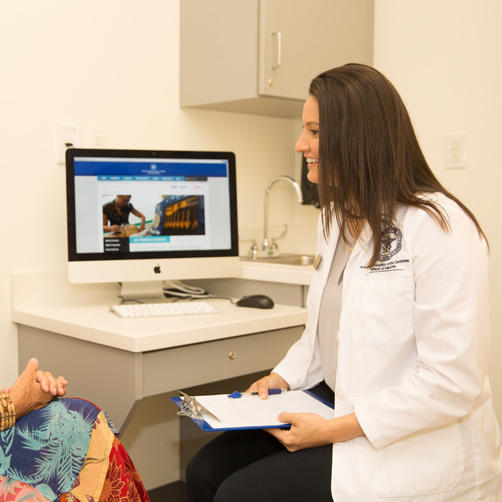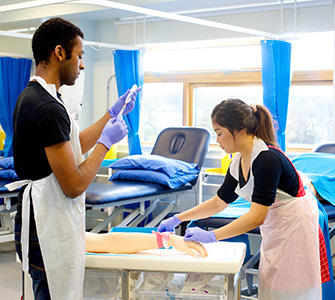Earning a Doctor of Medicine (MD) degree is a huge accomplishment, but it is not the end of the journey. New MDs must decide which of the many different types of doctors they want to be, and how much time they want to dedicate to post-graduate training. The American Association of Medical Colleges (AAMC) lists more than 135 medical specialties and subspecialties available for graduating physicians to pursue, and each one requires a residency of between three and eight years. Some medical fields also require further years of fellowship study. American University of the Caribbean School of Medicine (AUC) has developed in-depth articles on the major doctor specialties and subspecialties. Click among the links to learn more.
Allergy and Immunology
Allergy and immunology is a subspecialty of internal medicine. An allergist-immunologist evaluates, diagnoses, and manages disorders involving the immune system. Such conditions include asthma, anaphylaxis, eczema, rhinitis, and reactions to drugs, foods, and insect stings. The field of allergy and immunology also includes the study of defects in host defense, immune deficiency diseases, and problems related to autoimmune disease, organ transplants, and faults in the immune system. Allergist-immunologists are tasked with figuring out which substance or allergen is causing a problem, how to eliminate that cause, and then treating the problem. Allergist-immunologists do a three-year residency in internal medicine or pediatrics before completing a two-year residency in allergy and immunology. The specialty may be combined with rheumatology in a three-year residency. Minimum postgraduate training: five years.
Anesthesiology
A doctor of anesthesiology—an anesthesiologist—practices anesthesia, the use of medication to produce a loss of sensation (particularly pain) in the body. Without anesthesia, most surgical operations would not be possible. Anesthesiologists are trained in the administration of anesthetics throughout surgery, childbirth, and other medical procedures. Anesthesiologists are important throughout perioperative care, which includes pre- and post-op responsibilities as well as care during procedures themselves. An anesthesiology residency lasts four years.
Subspecialties include:
- adult cardiothoracic anesthesiology
- critical care or pain medicine
- obstetric anesthesiology
- pediatric anesthesiology
Cardiology
Cardiology is a subspecialty of internal medicine. A doctor of cardiology—a cardiologist—deals with diseases and maladies of the heart and blood vessels (the cardiovascular system). Cardiologists are experts in the processes and prevention of heart disease, as well as in ways to improve survival rates and the quality of life for people who have suffered from such cardiovascular problems as heart attacks or coronary artery disease. Cardiologists do a three-year residency in internal medicine before completing a three-year residency in cardiology. Minimum postgraduate training: six years.
Subspecialties include:
- advanced heart failure and transplant cardiology
- clinical cardiac electrophysiology
- interventional cardiology
Colon and Rectal Surgery
Colon and rectal surgeons diagnose and treat diseases of the anal canal, colon, intestinal tract, perianal area, and rectum by both medical (nonsurgical) and surgical means. When dealing with intestinal disease, these medicine specialists may also treat the female reproductive system, liver, or urinary tract. Colon and rectal surgeons operate to treat problems of the intestine and colon, and perform endoscopic procedures to deal with cancer, inflammatory conditions, and polyps. These specialists often treat such conditions as abscesses, constipation, incontinence, fissures, fistulae, and hemorrhoids through medical means. Minimum postgraduate training: six years.
Dermatology
A doctor of dermatology—a dermatologist—finds, prevents, and treats diseases of the skin, hair, nails, and adjacent mucous membranes. Dermatologists identify and treat more than 3,000 conditions, and they help improve the quality of life for people suffering from minor and irritating conditions to severe and life-threatening maladies. Dermatologists do a preliminary residency year in a broad-based clinical specialty (usually internal medicine) before completing a three-year residency in dermatology. Minimum postgraduate training: four years.
Subspecialties include:
- dermatopathology
- micrographic surgery
- dermatologic oncology
Emergency Medicine
A doctor of emergency medicine—an emergency physician—is a specialist in diagnosing and treating unforeseen injury or illness. In practice, an emergency medicine physician is a triage expert and specializes in taking quick action and making split-second decisions. Many emergency doctors work in the emergency department of a hospital or other facility and care for patients in the emergency room. An emergency medicine residency may combine with internal medicine or other disciplines and generally lasts three to four years.
Subspecialties include:
- medical toxicology
- pediatric emergency medicine
- sports medicine
Family Medicine
A doctor of family medicine—a family physician—provides primary medical care to people in every stage of life. Versatile family practice physicians treat men and women, young and old. They may provide care from before birth, throughout childhood and adulthood, and into old age. Family medicine often attracts doctors interested in a broad range of primary care and in the building of patient relationships that may last for many years. A family medicine residency is three years, but many physicians advance to combine family medicine with another specialty or with such subspecialties as geriatric or sports medicine.
Forensic Pathology
Forensic pathology is a subspecialty of pathology that examines cases of sudden, suspicious, or violent death. Forensic pathologists try to determine the time of death, cause of death (specific injury or disease), manner of death (natural, accidental, suicidal, homicidal, or undetermined), and, if necessary, what kind of instrument caused the death. These specialists may report their findings to insurance companies, families, or courts of law. Forensic pathologists also serve as expert witnesses in court trials. A residency in forensic pathology lasts from three to five years.
General Surgery
General surgeons are specially trained to perform complicated procedures, and they operate to treat disease, deformities, and injuries. General surgery includes a broad spectrum of surgical conditions affecting almost any area of the body. A general surgeon makes the diagnosis and provides perioperative care to patients. General surgeons are often responsible for the comprehensive care of trauma victims and critically ill patients. Surgeons must be capable in nearly all forms of surgery, and they should be able to handle a variety of emergencies and unexpected events in the operating room. A general surgery residency is five years.
Subspecialties include:
- hand surgery
- pediatric surgery
- surgical critical care
- vascular surgery
Genetics and Genomics
Medical geneticists evaluate, diagnose, and manage genetic disorders and birth defects, and they help patients and their families understand and cope with such disorders. Geneticists provide genetic counseling through the use of biochemical, cytogenetic, and radiologic testing. These types of doctors also use therapeutic interventions and aid in prevention through prenatal diagnosis. A medical geneticist plans and coordinates screening programs for inborn errors of blood, chromosome, metabolism, and spinal cord abnormalities and disorders. A genetics and genomics residency is three years.
Subspecialties include:
- biochemical genetics
- molecular genetic pathology
Hospice and Palliative Medicine
Hospice and palliative medicine is a subspecialty that may stem from various specialties. Hospice care is given to patients with terminal conditions who no longer wish to undergo curative treatment. Palliative medicine involves the treatment of symptoms and pain caused by serious illness. Physicians trained in hospice and palliative medicine do their best to relieve symptoms and reduce suffering. They try to improve the quality of life for patients and support patients and family throughout difficult treatment processes or end-of-life stages. A single-year hospice and palliative medicine residency may follow residencies in anesthesiology; emergency, family, or internal medicine; obstetrics and gynecology; pediatrics; physical medicine and rehabilitation; psychiatry; neurology; or radiology. Minimum postgraduate training: four years.
Hospital Medicine
Hospital medicine is a subspecialty, usually of internal medicine. A doctor of hospital medicine—a hospitalist—works exclusively in a hospital and provides general medical care to hospitalized patients. Aside from clinical care, hospitalists also teach, do research, and work to improve hospital and healthcare system performance. Hospitalists may complete a three-year residency in emergency, family, internal, or pediatric medicine before doing a one-year fellowship in hospital medicine. Minimum postgraduate training: four years.
Subspecialties include:
- emergency medical services
- hospice and palliative medicine
- neurocritical care
- pediatric hospital medicine
- sports medicine
- toxicology
- undersea and hyperbaric medicine
Internal Medicine
Internal medicine is a broad and versatile discipline that often serves as a preliminary specialty before physicians enter a wide range of other medical specialties or subspecialties. Doctors of internal medicine—internists—evaluate, diagnose, and manage the wide spectrum of disorders and illnesses that affect adults. Internists may serve as primary care physicians and deal with chronic illness as well as disease prevention and health promotion. Internal medicine covers all medical problems and organ systems in adults, making it an ideal foundation for physicians who wish to pursue additional training. An internal medicine residency lasts three years.
Subspecialties include:
- cardiovascular, infectious, or pulmonary disease
- critical care, geriatric, or sports medicine
- endocrinology, diabetes, and metabolism
- gastroenterology
- hematology
- medical oncology
- nephrology
- transplant hepatology
Neurology
Neurologists diagnose, treat, and manage conditions of the nervous system, which includes the brain, muscles, peripheral nerves, and spinal cord, as well as the blood vessels that relate to these structures. Neurologists use such diagnostic tests as computer-assisted tomography (CAT) scans, electroencephalograms (EEG), and magnetic resonance imaging (MRI) to identify neurological problems. Neurologists may treat Alzheimer’s disease, encephalitis, epilepsy, headaches and other pain, learning disabilities, meningitis, muscular dystrophy, multiple sclerosis, neurodevelopmental disorders, Parkinson’s disease, strokes, tumors, and other chronic conditions. A neurology residency lasts between four and five years.
Subspecialties include:
- child neurology
- clinical neurophysiology
- endovascular surgical neuroradiology
- neuromuscular or pain medicine
Neurological Surgery
Neurological surgery treats disorders of the central, peripheral, and autonomic nervous systems, including their supporting structures and vascular supply. Neurological surgeons provide such nonoperative management as critical care, diagnosis, evaluation, prevention, and rehabilitation, as well as such procedures as endovascular surgery, functional and restorative surgery, spinal fusion, and stereotactic radiosurgery. Neurosurgeons treat disorders of the brain, the extracranial carotid and vertebral arteries, the meninges, and the skull. Neurosurgeons also treat disorders of the cranial and spinal nerves, the pituitary gland, the spinal cord, and the vertebral column. A neurological surgery residency lasts seven years.
Obstetrics and Gynecology
Obstetrics (women’s healthcare during pregnancy, childbirth, and the postpartum period) and gynecology (reproductive health and the functions and diseases specific to women and girls) are different disciplines, but they are paired in residency and often in practice. An obstetrician gynecologist (OB/GYN) handles both disciplines and is an overall expert on women’s health. An OB/GYN provides women’s health services, particularly those related to the reproductive organs. OB/GYNs often serve as primary care doctors. They work with their hands, they counsel their patients, and they perform diagnostic procedures, surgeries, and other treatments. They may treat such issues as urinary tract infections and incontinence. They may also deliver babies and treat abnormal bleeding, genital itching, and hormone disorders. OB-GYNs provide a range of preventive care services, including birth control and immunizations. An obstetrics gynecology residency is typically four years.
Subspecialties include:
- female pelvic medicine and reconstructive surgery
- gynecologic oncology
- maternal-fetal medicine
- reproductive endocrinology and infertility
Ophthalmic Surgery
Ophthalmic surgery treats diseases and disorders of the eyes. Ophthalmologists may provide corrective vision services (eyeglasses or contacts) or perform laser-assisted in situ keratomileusis (LASIK) or photorefractive keratectomy (PRK) surgeries to correct vision problems. They may also operate to treat such disorders as cataracts, diabetic retinopathy, glaucoma, macular degeneration, or strabismus (cross-eyes). An ophthalmology residency lasts four years.
Subspecialties include:
- cornea and external disease
- ocular oncology
- neuro-ophthalmology
- ophthalmic plastic and reconstructive surgery
- vitreoretinal disease
Orthopaedic Surgery
Orthopaedic (also spelled orthopedic) surgery is devoted to the care of the musculoskeletal system—the body’s bones, joints, muscles, associated nerves, arteries, and the overlying skin. Orthopaedic surgeons treat such problems as bone fractures, injuries to tendons and ligaments, and deformities of the limbs and spine. An orthopaedist may use braces, casts, physical therapy, or splints to treat patients. Orthopaedic surgery may be required to treat congenital deformities, degenerative conditions, infections, metabolic disturbances, trauma, and tumors. An orthopaedic surgeon’s expertise may also include the surgical treatment of cerebral palsy, paraplegia, or stroke. An orthopaedic surgery residency lasts five years. Because of the wide scope of the musculoskeletal system, orthopaedic surgery includes various subspecialties, all of which require additional training.
Subspecialties include:
- adult reconstructive orthopaedics
- hand surgery
- musculoskeletal oncology
- orthopaedic sports medicine
- orthopaedic surgery of the spine
- pediatric orthopaedics
Otolaryngology
Doctors of otolaryngology—otolaryngologists—evaluate, diagnose, and manage problems of the ear, nose, and throat, as well as the rest of the head and neck. Often called ENTs (Ear, Nose, and Throat physicians), they deal with common complaints related to allergies, ear infections, sinusitis, and speech or swallowing problems. But ENTs also treat such severe problems as cancers, nerve pain, thyroid conditions, traumatic injuries, and tumors, and they may perform plastic or reconstructive surgery. An otolaryngology residency generally lasts five years.
Subspecialties include:
- neurotology
- pediatric otolaryngology
Pathology
Pathologists are experts in the diagnosis, prognosis, and treatment of disorders of body tissues and fluids. Pathology— the study of disease—combines science and medicine, and it requires an extensive and detailed knowledge of both. Pathology deals with every aspect of patient care, from disease prevention and diagnostic testing and treatment to the use of new technologies. Pathologists identify and treat numerous conditions, and they can help improve the quality of life for people with chronic and often life-threatening maladies. A pathology residency lasts three to four years. Doctors of pathology may follow or combine analytic, diagnostic, or forensic pathology residencies.
Subspecialties include:
- blood banking-transfusion medicine
- chemical pathology
- cytopathology
- hematology
- medical microbiology
- neuropathology
- pediatric pathology
Pediatrics
A doctor of pediatrics—a pediatrician—cares for infants, children, adolescents, and young adults. Pediatricians care for the physical as well as the emotional and psychological health of children. Pediatricians treat illness, injuries, and infections, and they also help ensure that children achieve milestones in their growth, behavior, and skills. Pediatricians also advise parents in matters of health, nutrition, safety, and fitness. A pediatric residency is three years, but many physicians combine pediatric medicine with another specialty.
Subspecialties include:
- adolescent medicine
- child abuse pediatrics
- developmental-behavioral pediatrics
- neonatal-perinatal medicine
- pediatric cardiology
- pediatric critical care medicine
- pediatric endocrinology
- pediatric gastroenterology
- pediatric hematology-oncology
- pediatric infectious diseases
- pediatric nephrology
- pediatric pulmonology
- pediatric rheumatology
- pediatric sports medicine
- pediatric transplant hepatology
Physical Medicine and Rehabilitation
A doctor of physical medicine and rehabilitation (PM&R), which is also known as physiatry, is called a physiatrist. Physiatrists are experts in the diagnosis, prognosis, and treatment of disorders of the musculoskeletal system. This system includes the bones that support the body, the muscles that move the body, and the connections between them. Physiatry also concerns the parts of the nervous system that control body movements and register pain. PM&R physicians do a preliminary year of internal medicine before completing a three-year PM&R residency. Minimum postgraduate training: four years.
Subspecialties include:
- neuromuscular medicine
- pain medicine
- spinal cord injury medicine
- sports medicine
Plastic Surgery
A plastic surgeon is an expert in the repair, reconstruction, or replacement of physical defects involving the breast and trunk, craniomaxillofacial structures, external genitalia, extremities, hands, musculoskeletal system, and skin, or the cosmetic enhancement of these parts of the body. Plastic surgeons also use cosmetic surgery to improve overall appearance and to optimize the outcome of reconstructive procedures. A plastic surgery residency lasts five to six years.
Subspecialties include:
- craniofacial surgery
- hand surgery
Preventive Medicine
Preventive medicine specialists are experts in disease prevention and health promotion. Preventive medicine physicians may help individuals, groups, communities, or entire populations maintain their health. Preventive medicine doctors assess medical conditions and perform physical examinations, make diagnoses and develop treatment plans, evaluate health programs and policies, and use diagnostic studies and tests. They may help people quit smoking, lose weight, eat healthfully, or reduce alcohol or drug use. Preventive medicine physicians also help ensure healthy pregnancies and safe work environments, treat depression, work in poison control, and administer vaccinations to prevent diseases and viruses. Preventive medicine residency usually begins with a transitional year of internal medicine followed by two years of a preventive medicine specialty. Doctors may also complete a three-year internal or family medicine residency and then add an extra year of preventive medicine training. Minimum postgraduate training: three years.
Subspecialties include:
- addiction medicine
- aerospace medicine
- occupational medicine
- undersea and hyperbaric medicine
- clinical informatics
- medical toxicology
- public health
Psychiatry
Psychiatrists are medical doctors that specialize in the diagnosis, prevention, and treatment of addictive, adjustment, anxiety, behavioral, emotional, mental, mood, psychotic, and sexual or gender identity disorders. As specially trained medical doctors, psychiatrists understand the biological, psychological, and social components of mental illness. Psychiatrists evaluate and treat patients through behavior modification, individual or group therapy, and psychoanalysis. They generally use a holistic approach to treatment, but psychiatrists also prescribe pharmacological treatments. A psychiatry residency is four years.
Subspecialties include:
- addiction psychiatry
- administrative psychiatry
- child and adolescent psychiatry
- community psychiatry
- consultation/ liaison psychiatry
- emergency psychiatry
- forensic psychiatry
- geriatric psychiatry
- intellectual disability psychiatry
- military psychiatry
- pain medicine
- psychiatric research
- psychosomatic medicine
Radiology
A radiologist is a doctor who interprets or “reads” medical images to diagnose and treat diseases or injuries. To generate these images, doctors of radiology use such technologies as computed tomography (CT) scanning, magnetic resonance imaging (MRI), nuclear imaging, positron emission tomography (PET), X-rays, and ultrasound. These images and the training radiologists use to read them are vital to detecting and treating illness, injury, and other chronic problems. A doctor of radiology may specialize as a diagnostic radiologist, an interventionist radiologist, or a radiation oncologist. Radiologists do a preliminary year in a broad-based clinical specialty such as internal medicine before completing a four- to six-year residency, depending on the radiology specialization. Minimum postgraduate training: five years.
Subspecialties include:
- abdominal radiology
- cardiothoracic radiology
- endovascular surgical neuroradiology
- musculoskeletal radiology
- neuroradiology
- nuclear medicine
- pediatric radiology
- vascular radiology
Rheumatology
Rheumatology is a subspecialty of internal medicine. A rheumatologist evaluates, diagnoses, and manages disorders involving the joints, muscles, and connective tissues. Rheumatologists treat a wide spectrum of disorders related to the musculoskeletal system, including autoimmune and inflammatory diseases that may involve other organ systems. Conditions treated by rheumatologists include arthritis, crystalline diseases, fibromyalgia, gout, lupus, osteoporosis, osteoarthritis, polymyalgia rheumatica, spondyloarthropathies, vasculitis, and common musculoskeletal and sports injuries. Rheumatologists do a three-year residency in internal medicine before completing a two-year residency in rheumatology. The specialty may be combined with allergy and immunology in a three-year residency. Minimum postgraduate training: five years.
Sleep Medicine
Sleep medicine is a subspecialty of internal medicine. Physicians trained in sleep medicine—somnologists—diagnose and treat sleep disturbances and disorders. Sleep medicine deals with circadian sleep disorders and such conditions as insomnia, narcolepsy, sleep apnea, and somnambulism. Somnologists do a three-year residency in internal medicine before completing a one-year residency in sleep medicine. Minimum postgraduate training: four years.
Thoracic Surgery
Thoracic surgeons specialize in surgeries of the chest. Thoracic—also called cardiothoracic—surgery ranks among the most high-intensity of medical specialties, as this area of the body includes some of the most vital and lifegiving organs—the heart and lungs. Thoracic surgeons perform such critical operations as open heart surgery and removal of cancerous lung tissue or tumors of the esophagus and chest wall. They treat abnormalities of the great blood vessels, including the aorta, and problems of the diaphragm, the chief muscle used in breathing. Thoracic surgeons also repair problems with the airways along with injuries of the chest. A thoracic surgery residency generally lasts seven years. Congenital cardiac surgery is a thoracic subspecialty.
Urology
Urologists—also known as genitourinary surgeons—diagnose and treat disorders of the urinary tracts. They also deal with the male reproductive system. Urologists handle such nonsurgical problems as urinary tract infections and prostatic hyperplasia, as well as such surgical problems as cancers, congenital abnormalities, and stress incontinence. A urology residency lasts at least five years. Pediatric urology is the main subspecialty.
Vascular Surgery
Vascular surgeons deal with diseases and disorders affecting the arteries, veins, and lymphatic systems, excluding vessels of the brain and heart. Vascular surgeons are also trained in nonsurgical treatment of vascular disease. Vascular surgeons may clear artery blockages, repair veins to improve circulation, and treat aneurysms in the aorta or vascular trauma. A vascular surgery residency lasts six to seven years.





